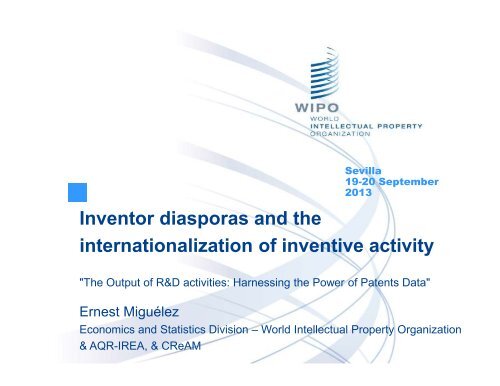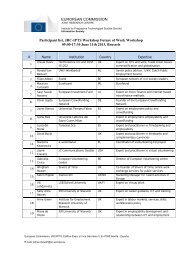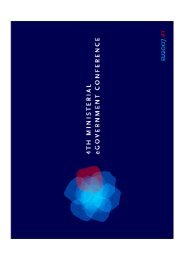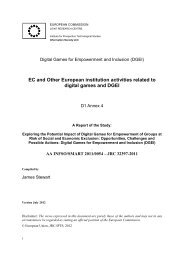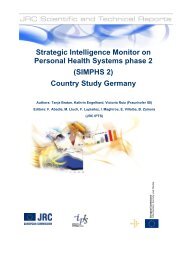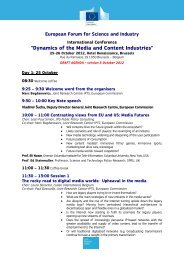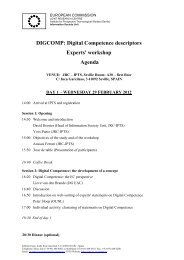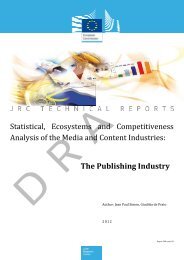Inventors' diaspora and the internationalisation of ... - JRC - EC
Inventors' diaspora and the internationalisation of ... - JRC - EC
Inventors' diaspora and the internationalisation of ... - JRC - EC
You also want an ePaper? Increase the reach of your titles
YUMPU automatically turns print PDFs into web optimized ePapers that Google loves.
Inventor <strong>diaspora</strong>s <strong>and</strong> <strong>the</strong><br />
Sevilla<br />
19-20 September<br />
2013<br />
internationalization <strong>of</strong> inventive activity<br />
"The Output <strong>of</strong> R&D activities: Harnessing <strong>the</strong> Power <strong>of</strong> Patents Data"<br />
Ernest Miguélez<br />
Economics <strong>and</strong> Statistics Division – World Intellectual Property Organization<br />
& AQR-IREA, & CReAM
Disclaimer<br />
The views expressed in this study are those <strong>of</strong> <strong>the</strong><br />
authors, <strong>and</strong> do not necessarily reflect <strong>the</strong> views <strong>of</strong> <strong>the</strong><br />
World Intellectual Property Organization or its Member<br />
States.
Motivation<br />
Firms internationalize innovation activity to exploit markets<br />
<strong>and</strong> technological advantages <strong>of</strong> foreign countries.<br />
For developing countries, int’l cooperation provides<br />
access to frontier knowledge <strong>and</strong> possibilities to catch-up<br />
(Hall, 2011)<br />
BUT, co-invention shows strong border effects:<br />
geography, institutions, language, social capital,<br />
High-skilled <strong>diaspora</strong>s may lower international transaction<br />
costs
Outline<br />
Research questions<br />
Literature review<br />
Methods<br />
Data<br />
Estimation results<br />
Conclusions
Research Questions<br />
What drives int’l co-inventorship <strong>and</strong> inventive<br />
internationalization b/ developed-developing countries?<br />
How does inventor int’l mobility look like?<br />
Is <strong>the</strong>re evidence <strong>of</strong> an association between highly-skilled<br />
<strong>diaspora</strong>s <strong>and</strong> co-inventorship?<br />
Do ethnic inventors in firms facilitate applicants’ expansion<br />
to countries associated with that ethnicity?<br />
Is all about China <strong>and</strong> India after all?
Literature Review<br />
Internationalization <strong>of</strong> R&D <strong>and</strong> inventive activities <strong>and</strong> int’l copatenting<br />
(Patel & Vega, 1999; Guellec & van Pottelberghe, 2001; Picci,<br />
2010; De Prato & Nepelski, 2012a,b; Riccaboni et al., 2013)<br />
Geography, culture, history, language, economic linkages, trust,<br />
soc. capital, market regulations, weak institutions (incl. IPRs)<br />
hamper int’l co-patenting.<br />
Main conclusions: co-invention is a national phenomenon<br />
Only 4.7% EPO & 6.2% USPTO - 1995 (Guellec & van Pottelberghe,<br />
2001)<br />
8% European patents in 2005 (Picci, 2010)<br />
8-9% <strong>of</strong> PCT co-patents during <strong>the</strong> 2000s<br />
Few papers look at developed-developing countries co-patenting –<br />
despite its implications (Montobbio <strong>and</strong> Sterzi, 2013)
Literature Review<br />
In a trade classical context (Heckscher–Ohlin), free movement <strong>of</strong><br />
factors substitutes free movement <strong>of</strong> goods (Egger et al., 2012)<br />
Migration could reduce trade, but also sending country HK<br />
endowments <strong>and</strong> negatively affect FDI (Kugler & Rapoport, 2007)<br />
Less skilled workers in sending countries reduces incentives to set up<br />
business (including co-patenting?) - & reduces incentives to migrate<br />
BUT migrants integrate to <strong>the</strong> business community <strong>of</strong> <strong>the</strong> host country:<br />
Network externalities are present<br />
Diasporas provide info. about business opportunities in both countries<br />
(reduces incomplete information problems)<br />
Substitute for trust – where contracts enforcement is weak (&<br />
institutions, such IPRs) - & provides info. about past opportunistic<br />
behavior (asymmetric information)<br />
Overcome barriers: cultural, linguistic, institutional, administrative or<br />
geographical
Literature Review<br />
Diasporas increase trade by 1-3% (Gould, 1994; Rauch & Trindade,<br />
2002; Head & Ries, 1998; Rauch, 2001, 2003; )<br />
Are pivotal in trade <strong>of</strong> more heterogeneous products, for which nondisclosed<br />
(<strong>and</strong> tacit) information is more relevant – <strong>and</strong> prices do not<br />
convey all relevant information<br />
Diasporas & FDI: 3-5% (Gao, 2003; Tong, 2005; Javorcick et al., 2011)<br />
Census-based data <strong>of</strong> tertiary educated migrants are used:<br />
no annual variation<br />
Heterogeneity on quality <strong>of</strong> <strong>the</strong> education received<br />
Rough differentiation across skills (3 levels <strong>of</strong> schooling)<br />
Diasporas <strong>and</strong> knowledge flows, particularly for inventors (Kerr, 2008;<br />
Agrawal et al., 2011)<br />
Homogeneity <strong>of</strong> skills<br />
Upper tail <strong>of</strong> skills distribution<br />
Patents are registered: large # <strong>of</strong> countries, regions, years <strong>and</strong> sectors
Literature Review<br />
Do inventor <strong>diaspora</strong>s influence inventor-to-inventor & applicant-toinventor<br />
networks between developed-developing countries?<br />
Do migration substitute <strong>the</strong> need to internationalize or <strong>the</strong>y correlate<br />
positively?<br />
US firms internationalization <strong>and</strong> firms’ ethnic inventors (Foley & Kerr,<br />
2013)<br />
Majority <strong>of</strong> migration-innovation studies, <strong>the</strong> US (Breschi et al., 2013)<br />
FDI/trade/knowledge-<strong>diaspora</strong> studies: US, China, India,<br />
Is all about China <strong>and</strong> India after all?<br />
Maybe <strong>the</strong> Indian <strong>and</strong> Chinese <strong>diaspora</strong>s are so famous for being <strong>the</strong><br />
exception ra<strong>the</strong>r than <strong>the</strong> rule (Gibson <strong>and</strong> McKenzie, 2011)
Methods<br />
Gravity model <strong>the</strong> determinants <strong>of</strong> inventor-to-inventor <strong>and</strong> applicant–<br />
to-inventor international co-patenting<br />
Between a group <strong>of</strong> developed (20) <strong>and</strong> a group <strong>of</strong> developing<br />
countries (99).<br />
Annual data from 1990 to 2010<br />
Specific role <strong>of</strong> inventor <strong>diaspora</strong>s in favoring international co-patenting<br />
PPML: large list <strong>of</strong> controls <strong>and</strong> fixed-effects included<br />
COPAT<br />
ijt<br />
= e<br />
β<br />
β<br />
ijt<br />
0<br />
DIASPORA<br />
1<br />
Z<br />
γ n<br />
ijt<br />
e<br />
τ<br />
i<br />
e<br />
τ<br />
j<br />
e<br />
δ<br />
t<br />
ε<br />
ijt
Data: dependent variable<br />
Share int’l co-patenting O<strong>EC</strong>D vs. nonO<strong>EC</strong>D<br />
Coll. O<strong>EC</strong>D countries O<strong>EC</strong>D&non-O<strong>EC</strong>D Coll. non-O<strong>EC</strong>D countries<br />
Share PCT co-patents<br />
O<strong>EC</strong>D vs. non-O<strong>EC</strong>D countries<br />
0 20 40 60 80 100<br />
1990 1995 2000 2005 2010<br />
Year
Data<br />
Inventors’ migratory background from PCT patents<br />
In order to apply for PCT patents, <strong>the</strong> applicants should be<br />
ei<strong>the</strong>r nationals or residents <strong>of</strong> a PCT country member<br />
Until 2012, US laws bind <strong>the</strong> applicant also to be <strong>the</strong> inventor<br />
If <strong>the</strong> US was a designated state (quite frequent), nationality<br />
information was available.<br />
Not inferred cultural origin <strong>of</strong> inventors’ names (like Kerr, 2008)<br />
‘Who is Who’ in <strong>the</strong>se patents? Not known.<br />
Individuals are inventor-patent pairs
Data<br />
Nationality & residence information in a PCT application
Data<br />
Coverage nationality information in PCT patents<br />
Records with missing<br />
or misrecorded data<br />
Records <strong>of</strong> inventors<br />
that are not applicants<br />
Records w/ Nationality &<br />
Residence Information<br />
Records (in thous<strong>and</strong>s)<br />
0 100 200 300 400 500<br />
Coverage: 80.6%<br />
The Leahy-Smith America Invents Acts<br />
(AIA) removed <strong>the</strong> requirement <strong>of</strong> inventors<br />
to be named as applicants in PCTs<br />
2004<br />
1978 1981 1984 1987 1990 1993 1996 1999 2002 2005 2008 2011<br />
Year
Data<br />
Top-10 most populated corridors, 2001-2010<br />
Largest inventor migration corridors<br />
Largest inventor migration corridors,<br />
limited to non-O<strong>EC</strong>D sending countries<br />
Origin Destination Counts Origin Destination Counts<br />
China United States 44,444 China United States 44,444<br />
India United States 35,607 India United States 35,607<br />
Canada United States 18,745 Russia United States 4,347<br />
U.K. United States 14,897 China Japan 2,514<br />
Germany United States 10,290 China Singapore 1,925<br />
Germany Switzerl<strong>and</strong> 8,199 Turkey United States 1,923<br />
R. <strong>of</strong> Korea United States 7,264 Iran United States 1,442<br />
France United States 6,540 Romania United States 1,229<br />
Japan United States 5,065 Russia Germany 1,217<br />
Russia United States 4,347 Mexico United States 1,164
Data<br />
Bilateral corridors: shares across world areas, 1990-2010<br />
North-North North-South South-North South-South<br />
Share bilateral flows<br />
across country groups<br />
0 20 40 60 80 100<br />
1990 1995 2000 2005 2010<br />
Year
Data<br />
Net migration position, 2001-2010<br />
Total migrants<br />
South-North migrants<br />
Country<br />
Share total Country<br />
Share total<br />
Immigrants<br />
Immigrants<br />
code<br />
immigrants code<br />
immigrants<br />
United States 194,609 57.17% United States 105,336 74.87%<br />
Germany 25,341 7.44% Germany 6,031 4.29%<br />
Switzerl<strong>and</strong> 20,416 6.00% Singapore 4,375 3.11%<br />
U.K. 15,758 4.63% Japan 3,927 2.79%<br />
Ne<strong>the</strong>rl<strong>and</strong>s 9,665 2.84% U.K. 3,729 2.65%<br />
France 9,540 2.80% Canada 2,503 1.78%<br />
Canada 7,257 2.13% France 2,230 1.59%<br />
Singapore 6,720 1.97% Ne<strong>the</strong>rl<strong>and</strong>s 2,128 1.51%<br />
Japan 6,715 1.97% Switzerl<strong>and</strong> 1,451 1.03%<br />
Belgium 5,042 1.48% Finl<strong>and</strong> 1,265 0.90%
Data<br />
Top 10 South-North migration corridors, 2001-2010<br />
4.3<br />
1.2<br />
RUSSIA<br />
1.2<br />
UNITED<br />
STATES<br />
GERMANY<br />
ROMANIA<br />
1.2<br />
TURKEY<br />
CHINA<br />
1.9<br />
IRAN<br />
1.4<br />
JAPAN<br />
MEXICO<br />
INDIA<br />
1.9<br />
2.5<br />
44.4<br />
Legend: Top 10<br />
South-North<br />
migration corridors,<br />
2001-2010<br />
Source:<br />
Recipient:<br />
Thous<strong>and</strong>s: 1.2<br />
35.6<br />
SINGAPORE
Data<br />
Where do Latin American inventors go?
Data<br />
Where do African inventors go?
Data<br />
Inventor <strong>diaspora</strong> size (# patent-inventor pairs 5-year time<br />
window)<br />
Inventor <strong>diaspora</strong> share in destination country<br />
Costs: distance, contiguity, common language, colonial past<br />
(Head, Mayer <strong>and</strong> Ries, 2010, CEPII)<br />
Trade (COMTRADE data)<br />
Technological distance (correlation between IPC codes, PCT pat.)<br />
# patents at origin<br />
# patents at destination<br />
GDP pc at origin<br />
GDP pc at destination
Estimation results: PPML<br />
Inventor-to-inventor Applicant-to-inventor<br />
ln(Diaspora) 0.181*** 0.0858**<br />
(0.0248) (0.0402)<br />
ln(Diaspora share) 0.286*** 0.170***<br />
(0.0268) (0.0493)<br />
ln(Distance) -0.275*** -0.239*** -0.0977 -0.0684<br />
(0.0686) (0.0674) (0.0885) (0.0890)<br />
Contiguity -0.0248 0.0122 -0.143 -0.103<br />
(0.125) (0.122) (0.220) (0.224)<br />
Common language 0.534*** 0.501*** 0.743*** 0.715***<br />
(0.115) (0.112) (0.187) (0.189)<br />
Colonial links 0.166 0.148 0.374** 0.356**<br />
(0.131) (0.126) (0.172) (0.181)<br />
ln(EXP+IMP) 0.0720*** 0.0552*** 0.0901*** 0.0748**<br />
(0.0236) (0.0204) (0.0305) (0.0291)<br />
ln(Tech.distance) -0.0963** -0.0887** -0.277*** -0.269***<br />
(0.0431) (0.0431) (0.0567) (0.0563)<br />
ln(# patents) orig. 0.321*** 0.331*** 0.344*** 0.343***<br />
(0.0581) (0.0513) (0.0734) (0.0696)<br />
ln(# patents) dest. 0.0297 0.0994 0.368 0.408<br />
(0.135) (0.139) (0.254) (0.266)<br />
ln(GDP p.c.) orig. 1.224*** 1.218*** 1.851*** 1.834***<br />
(0.241) (0.197) (0.335) (0.310)<br />
ln(GDP p.c.) dest. -0.394 -0.933 -0.925 -1.247<br />
(0.593) (0.607) (0.873) (0.870)<br />
Observations 31,680 31,680 32,400 32,400<br />
Pseudo R2 0.959 0.960 0.915 0.913<br />
Origin FE Yes Yes Yes Yes<br />
Destination FE Yes Yes Yes Yes<br />
Year FE Yes Yes Yes Yes
Estimation results: PPML<br />
Inventor-to-inventor Applicant-to-inventor<br />
ln(Diaspora) 0.227*** 0.121***<br />
(0.0260) (0.0396)<br />
ln(Diaspora share) 0.263*** 0.121***<br />
(0.0256) (0.0441)<br />
ln(Distance) -0.0263 -0.0707 0.137* 0.114<br />
(0.0599) (0.0608) (0.0784) (0.0802)<br />
Contiguity -0.168 -0.182 -0.299 -0.312<br />
(0.115) (0.113) (0.207) (0.208)<br />
Common language 0.316*** 0.320*** 0.540*** 0.548***<br />
(0.0976) (0.0944) (0.161) (0.161)<br />
Colonial links 0.158 0.180* 0.334** 0.348**<br />
(0.106) (0.108) (0.146) (0.145)<br />
ln(EXP+IMP) 0.257*** 0.239*** 0.307*** 0.306***<br />
(0.0390) (0.0397) (0.0534) (0.0552)<br />
ln(Tech.distance) -0.185*** -0.200*** -0.341*** -0.349***<br />
(0.0501) (0.0504) (0.0719) (0.0723)<br />
Constant -1.089* 2.117*** -3.214*** -1.655**<br />
(0.607) (0.596) (0.760) (0.831)<br />
Observations 20,757 20,757 23,300 23,300<br />
Pseudo R2 0.978 0.977 0.953 0.953<br />
Origin FE Yes Yes Yes Yes<br />
Destination FE Yes Yes Yes Yes<br />
Year FE No No No No<br />
Origin FE*Time FE Yes Yes Yes Yes<br />
Destination FE*Time FE Yes Yes Yes Yes
Estimation results: PPML<br />
Electrical<br />
engineering<br />
Instruments Chemistry Mechanical<br />
ln(Diaspora) 0.221*** 0.169*** 0.161*** 0.159***<br />
(0.0443) (0.0290) (0.0238) (0.0367)<br />
ln(Distance) -0.0931 -0.391*** -0.298*** -0.434***<br />
(0.0881) (0.0673) (0.0695) (0.0826)<br />
Contiguity 0.0308 0.289* -0.240 0.310<br />
(0.247) (0.151) (0.177) (0.198)<br />
Common language 0.255 0.834*** 0.455*** 0.545***<br />
(0.216) (0.123) (0.118) (0.137)<br />
Colonial links 0.104 -0.0714 0.266* 0.159<br />
(0.188) (0.155) (0.158) (0.164)<br />
ln(EXP+IMP) 0.166*** 0.0628* 0.0719*** 0.0234<br />
(0.0537) (0.0357) (0.0265) (0.0467)<br />
ln(Tech.distance) -0.230*** 0.0149 0.0485 -0.0599<br />
(0.0719) (0.0527) (0.0517) (0.0696)<br />
Controls Yes Yes Yes Yes<br />
Observations 25,920 25,600 33,200 24,660<br />
Pseudo R2 0.933 0.891 0.912 0.808<br />
Origin FE Yes Yes Yes Yes<br />
Destination FE Yes Yes Yes Yes<br />
Year FE Yes Yes Yes Yes
Estimation results: PPML<br />
No BRICS No US<br />
No BRICS, No BRICS,<br />
no US no US<br />
ln(Diaspora) 0.159*** 0.204*** 0.188*** 0.191***<br />
(0.0392) (0.0372) (0.0433) (0.0469)<br />
ln(Distance) -0.381*** -0.323*** -0.465*** -0.265***<br />
(0.0680) (0.0617) (0.0706) (0.0827)<br />
Contiguity -0.128 -0.224 -0.284* -0.332**<br />
(0.124) (0.145) (0.160) (0.157)<br />
Common language 0.667*** 0.285** 0.293* 0.216<br />
(0.166) (0.128) (0.157) (0.150)<br />
Colonial links 0.139 0.360*** 0.407*** 0.341**<br />
(0.160) (0.120) (0.148) (0.142)<br />
ln(EXP+IMP) 0.108*** 0.0281 0.0595** 0.226***<br />
(0.0259) (0.0211) (0.0240) (0.0468)<br />
ln(Tech.distance) -0.122** -0.0163 0.0309 -0.0121<br />
(0.0604) (0.0667) (0.0685) (0.0816)<br />
Controls Yes Yes Yes No<br />
Observations 33,620 32,680 30,799 15,820<br />
Origin FE Yes Yes Yes Yes<br />
Destination FE Yes Yes Yes Yes<br />
Year FE Yes Yes Yes No<br />
Origin FE*Time No No No Yes<br />
FE<br />
Destination<br />
No No No Yes<br />
FE*Time FE<br />
Destination<br />
FE*Time FE<br />
No No No Yes
Conclusions<br />
Robust positive association between inventor <strong>diaspora</strong> <strong>and</strong><br />
inventor-inventor int’l co-patenting<br />
Int’l social networks relate to int’l business networks<br />
Results are surprisingly positive at lower levels <strong>of</strong> inventor <strong>diaspora</strong><br />
(not dependent on India, China or <strong>the</strong> US)<br />
Weaker for applicant-inventor co-patents: more formal <strong>and</strong><br />
hierarchical relations, contracts less tacit <strong>and</strong> contract enforcement<br />
is possible<br />
Consequences <strong>of</strong> brain drain <strong>of</strong> inventors, somewhat mitigated<br />
Methodological paper <strong>and</strong> data available:<br />
Ernest Miguélez & Carsten Fink (2013) “Measuring <strong>the</strong> International Mobility <strong>of</strong><br />
Inventors: A New Database” WIPO Economics Publications, No. 8
Conclusions (caveats)<br />
Results too robust to be credible?<br />
Not diminished effect when removing US <strong>and</strong> BRICS<br />
Robust to different estimation methods<br />
Few differences across broad technologies (not analyzed at finer<br />
tech levels)<br />
There remain some issues <strong>of</strong> omitted variables that need to be<br />
solved (IV-PPML)<br />
More substantive hypo<strong>the</strong>ses to explore? Suggestions?<br />
Uneven distribution <strong>of</strong> inventors within countries? Does firm<br />
(applicant) heterogeneity matters?
Inventor <strong>diaspora</strong>s <strong>and</strong> <strong>the</strong><br />
internationalization <strong>of</strong> inventive activity<br />
Ernest Miguélez<br />
Thanks!<br />
Sevilla<br />
19-20 September<br />
2013<br />
Economics <strong>and</strong> Statistics Division – World Intellectual Property Organization<br />
& AQR-IREA, & CReAM


